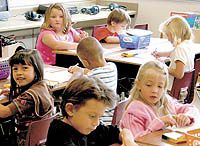| Students prepare for the first day of school in Mrs. Avery’s first grade class at Bruin Point Elementary. The new state-of-the-art primary school in Sunnyside was a welcomed addition to the east county city after the demolition of East Carbon High School. |
School has started and Carbon County motorists are cautioned to remain on constant alert for local students.
In addition, local residents are reminded that drivers who fail to comply with posted school zone speed limits face criminal prosecution and increased penalties.
•Law enforcement authorities and traffic safety experts encourage Carbon County motorists to:
Slow down near schools and stop at all intersections.
Drivers should also travel at reduced speeds in residential areas.
Operate vehicles with the headlights on even during the day.
The lights will help children and other drivers see vehicles.
Watch for safety patrollers, crossing guards, bicycles and playgrounds.
Scan between parked cars and other objects for signs that children could dart into the road.
Pay particular attention near schools during the morning and afternoon hours.
Always stop for school buses that are loading and unloading students.
•In addition, AAA Utah encourages Carbon County residents to:
Set clear driving rules with teenagers.
Adults should consider drawing up a parent-teen agreement spelling out curfews, standards of driving behavior, prohibited activities and resulting punishments.
Enforce passenger restrictions.
State law prohibits teenage motorists from carrying passengers inside vehicles for the first six months the youth have a license.
Parents should limit the number of passengers for as long as they determine necessary after the first six months.
Crash rates increase drastically for 16- and 17-year-old drivers as passengers are added to a car.
•Do not permit youth to ride with a new teen driver.
Carpooling with a schoolmate seems like a sensible way for teens to ride a school, home and activities, but it can promote risky behavior.
Research shows that it is more dangerous for several teens to ride in one care than for them to drive individually in multiple vehicles.
Ban all cell phone usage inside motor vehicles.
Teens have trouble managing distractions, especially while driving.
Require teenagers to wear seatbelts while riding in or operating motor vehicles Teens have the lowest belt use rate of any age group.
Make the driving rules known to other adults in the teenagers’ lives. Parent-to-parent agreements involving the teenage drivers’ friends or teammates can establish standard rules among groups of youth.
Letting neighborhoods know a teen’s driving rules can give parents an extra sets of eyes when they are not around.
•Parents of children who walk to school should teach students to:
Take the most direct and safest route.
If a shorter route is not safe, adults should explain to children why the longer way is better. Select the route with the fewest street crossings.
Use pedestrian tunnels or overpasses to avoid hazardous traffic.
Pick intersections guarded by an adult crossing guard or school safety patroller.
Avoid confusing and complicated intersections.
When available, always use intersections where children are likely to cross with a group of people.
Look for intersections that have a signal with a separate pedestrian interval or walk/don’t walk indicator.
Stick to routes with sidewalks, pathways and bike paths.
Avoid streets where your child’s view is blocked to the oncoming traffic.
Teach children to face approaching traffic in areas where there are no sidewalks.
If a parent is accompanying with the child, the adult should walk between the child and the road.
Cross only at corners or at a marked crosswalk.
Stop and look all ways before crossing.
Crosswalks are not always safe areas. Children must be alert.
Be especially alert in bad weather.
Visibility is reduced, drivers cannot stop quickly, and cars may skid.
•Be visible at night.
If children are out after dark, have the youth carry a flashlight and wear white or bright-colored clothing.
It’s also a good idea to use reflective strips on jackets, coats, hats and backpacks.
Watch for turning cars at all times, especially with right-turn-on-red laws in effect.

